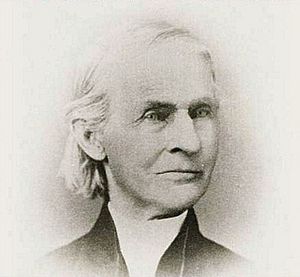Thomas M'Clintock facts for kids
Quick facts for kids
Thomas M'Clintock
|
|
|---|---|
 |
|
| Born |
Thomas McClintock
March 28, 1792 |
| Died | March 19, 1876 (aged 83) |
| Occupation | Pharmacist |
| Known for | Driving force in abolitionism |
| Spouse(s) |
Mary Ann Wilson
(m. 1820) |
Thomas M'Clintock (born March 28, 1792 – died March 19, 1876) was an American pharmacist. He was a very important leader in the Quaker community. He worked hard for many big changes. These included ending slavery, getting equal rights for women, and updating the Quaker religion.
Contents
Thomas M'Clintock's Early Life
Thomas M'Clintock was born on March 28, 1792, in Delaware. His father was a Presbyterian, and his mother was a Quaker. His mother was removed from the Quaker group for marrying someone outside their faith.
Thomas became a pharmacist, which was called a druggist back then. He learned this job by working as an apprentice. In 1811, Thomas decided to become a Quaker. When he was 22, he opened his own pharmacy in Philadelphia.
Six years later, in 1820, he married Mary Ann Wilson in Burlington, New Jersey. They lived in Philadelphia for 17 years. During this time, Thomas started working to end slavery. Thomas and Mary Ann had six children, and five of them lived to be adults.
Fighting Against Slavery
In 1827, M'Clintock helped start the Free Produce Society of Pennsylvania. He worked with people like James Mott and Richard Allen. This group was mostly Quakers and free African Americans.
They wanted to sell goods that were not made by enslaved people. They hoped this would create a demand for "free" products. The society believed this was a peaceful way to fight slavery. Thomas followed these ideas throughout his life.
Changes in the Quaker Faith
In 1827, M'Clintock was also a key person in the Hicksite Schism. This was a big split among Quakers. They disagreed about church rules and how much they should be involved in social causes.
Thomas knew a lot about early Quaker beliefs. He used his knowledge to argue against the Orthodox Quakers. His arguments caused so much tension. Ten years later, in 1836, he and his family moved to Waterloo, New York.
Working for Social Change
In Waterloo, the M'Clintocks became closer to William Lloyd Garrison. He led the American Anti-Slavery Society. The M'Clintocks helped with petitions and anti-slavery fairs. They also hosted many speakers who were against slavery.
They were founding members of the Western New York Anti-Slavery Society. In 1843, Thomas joined the board of the American Anti-Slavery Society. He later became a vice president for several years. M'Clintock strongly supported ending slavery. He also worked for the temperance movement (which aimed to reduce alcohol use) and Native American rights.
Thomas and his wife organized anti-slavery petitions. They also gave shelter to Black children. They continued to support the Free Produce movement.
Religion has been emphatically embodied, not in speculative theories, but in practical righteousness.
New Quaker Groups
In the 1840s, there were more disagreements within the Hicksite Quakers. They argued about whether leaders could discipline members. They also debated if Quakers should work with non-Quakers in reform groups. The role of women in the organization was another issue.
The M'Clintocks were important in another Quaker split in 1848. This led to the creation of the Yearly Meeting of Congregational Friends. Thomas M'Clintock wrote the rules for this new group. These rules said there would be no ministers. No member would be above another. Men and women would meet together with equal power. Members did not have to follow a specific set of beliefs. Anyone, even non-Quakers, could join. Other similar groups started in different places later on.
Supporting Women's Rights
Thomas's wife, Mary Ann, was a major leader in organizing the Seneca Falls Convention. This was the very first convention for women's rights. She was at a famous tea party where the idea for the convention was first discussed.
The original Declaration of Sentiments was written at the M'Clintock house. Elizabeth Cady Stanton, Mary Ann, and probably Elizabeth and Mary M'Clintock wrote it. Thomas might have been part of these talks, but there is no direct record. He did lead one of the convention sessions. He also gave a speech supporting the declaration.
The whole M'Clintock family was involved in this convention. They also helped organize a follow-up convention. This was the Rochester Women's Rights Convention of 1848, held two weeks later in Rochester, New York.
Later Years and Legacy
By 1860, when he was 68, Thomas M'Clintock moved back to Philadelphia with his family. He worked as a pharmacist again until about 1866. He passed away on March 19, 1876, at 83 years old. His wife, Mary Ann, died eight years later on May 21, 1884.
Thomas M'Clintock is remembered for his work to end slavery. He also had a big impact on the first movements for women's rights. The house where his family lived in Waterloo, New York in July 1848 is now a historic landmark. It was listed on the National Register of Historic Places in 1980 as the M'Clintock House.

